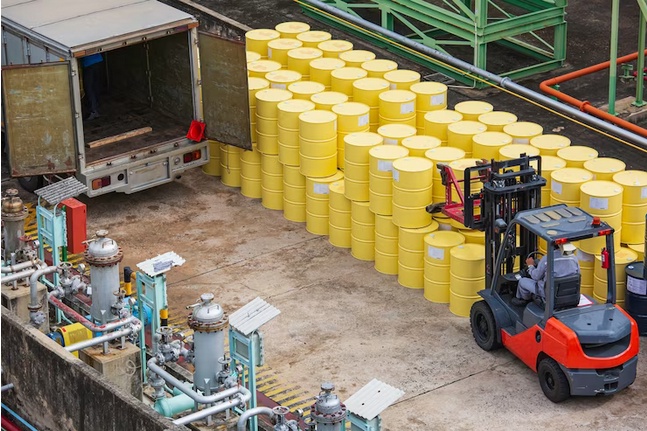Introduction
In industries ranging from manufacturing to logistics, the handling of drums and barrels is a common yet challenging task. Drum handling equipment plays a crucial role in facilitating the safe and efficient movement of these containers, ensuring both worker safety and operational efficiency. This comprehensive guide delves into the various solutions available for drum handling equipment in the UK, examining their types, applications, safety considerations, and benefits.
Understanding Drum Handling Equipment
Drum handling equipment encompasses a wide range of tools and machinery designed to lift, move, and manipulate drums and barrels safely and efficiently. These equipment solutions are essential for industries where the handling of drums is a routine part of operations, such as chemical processing plants, food and beverage manufacturing facilities, and warehouses. Drum handling equipment comes in various forms, including drum lifters, drum dollies, drum tilters, and drum rotators, each serving specific purposes in the handling process.
Types of Drum Handling Equipment
-
Drum Lifters: Drum lifters are devices designed to securely grip and lift drums off the ground, allowing for easy transportation and positioning. They come in different configurations, including manual, hydraulic, and pneumatic lifters, each offering varying lifting capacities and features.
-
Drum Dollies: Drum dollies are wheeled platforms equipped with casters or wheels that allow for the effortless movement of drums across flat surfaces. They are particularly useful for transporting drums within a facility or loading them onto vehicles for transportation.
-
Drum Tilters: Drum tilters are devices designed to tilt drums to pour or decant their contents safely. They feature adjustable angles and locking mechanisms to ensure precise control over the pouring process while minimizing the risk of spills or accidents.
-
Drum Rotators: Drum rotators are specialized equipment designed to rotate drums horizontally or vertically, allowing for thorough mixing, blending, or emptying of contents. They are commonly used in industries where the uniformity of the drum's contents is critical, such as paint manufacturing or pharmaceutical production.
Applications of Drum Handling Equipment
Drum handling equipment finds widespread use across various industries and applications, including:
- Chemical Processing: Transferring, mixing, and dispensing hazardous chemicals and liquids stored in drums.
- Food and Beverage: Handling and transporting bulk quantities of ingredients, oils, and beverages in drums.
- Manufacturing: Manipulating drums during the production process, such as filling, emptying, or packaging operations.
- Warehousing and Logistics: Storing, stacking, and transporting drums within warehouses or distribution centers.
Safety Considerations
Safety is paramount when handling drums, as they often contain hazardous materials or heavy loads that pose risks to workers and property. When using drum handling equipment, several safety considerations must be taken into account to minimize the risk of accidents and injuries:
-
Equipment Selection: Choose drum handling equipment that is suitable for the specific application and environment, ensuring that it has the necessary load capacity and features to handle the intended tasks safely.
-
Operator Training: Provide comprehensive training to operators on the safe use of drum handling equipment UK, including proper operating procedures, load limitations, and emergency protocols.
-
Inspection and Maintenance: Regularly inspect drum handling equipment for signs of wear, damage, or malfunction, and perform routine maintenance to ensure optimal performance and reliability.
-
Personal Protective Equipment (PPE): Require operators to wear appropriate PPE, such as gloves, safety goggles, and protective clothing, when handling drums to minimize the risk of exposure to hazardous substances or injury from moving parts.
Benefits of Drum Handling Equipment
Investing in drum handling equipment offers several benefits for businesses, including:
- Improved Efficiency: Drum handling equipment streamlines handling processes, reducing manual labor and increasing productivity.
- Enhanced Safety: By minimizing manual lifting and handling tasks, drum handling equipment reduces the risk of workplace injuries and accidents.
- Protective of Product: Proper handling and manipulation of drums using specialized equipment help prevent spills, leaks, and contamination, preserving the integrity of the product.
- Compliance: Using dedicated drum handling equipment helps businesses comply with health and safety regulations and industry standards governing the handling and transportation of hazardous materials.
Conclusion
Drum handling equipment solutions play a vital role in the safe and efficient handling of drums and barrels across various industries in the UK. By understanding the types, applications, safety considerations, and benefits of drum handling equipment outlined in this guide, businesses can make informed decisions when selecting and implementing these solutions in their operations. With proper training, maintenance, and adherence to safety protocols, drum handling equipment can enhance workplace safety, productivity, and compliance, ensuring optimal performance and peace of mind for all stakeholders involved.


No comments yet